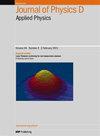作为高效储氢材料的掺锆 C24 富勒烯:DFT 模拟的启示
IF 3.2
3区 物理与天体物理
Q2 PHYSICS, APPLIED
引用次数: 0
摘要
在这篇文章中,我们利用最先进的密度泛函理论模拟,报告了锆 (Zr) 装饰 C24 富勒烯的储氢能力。我们的研究表明,锆和其他大多数过渡金属一样,倾向于与 C24 富勒烯的 C-C 桥紧密结合,其最大结合能为 -3.64 eV。装饰在 C24 富勒烯上的每个锆原子最多可吸附 7 个 H2 分子,平均吸附能为 -0.51 eV/H2,从而使重量密度达到 7.9 wt%,高于美国能源部规定的 6.5 wt% 的目标。Zr 与 C24 富勒烯中的 C 原子之间存在电荷转移,这是 Zr 与 C24 富勒烯结合的主要原因。H2 分子通过库巴斯(Kubas)型相互作用吸附在 Zr 吸附位点上,其中包括从氢的填充 s 轨道到 Zr 的空闲 4d 轨道的电荷转移,以及随后从 Zr 的填充 4d 轨道到氢的未填充 s* 轨道的反向电荷转移。通过非原位分子动力学计算,验证了 Zr + C24 体系在 500 K 高温下的结构稳定性。Zr 的高扩散能垒(2.33 eV)抑制了装饰在 C24 富勒烯上的 Zr 原子间的团聚,确保了该体系作为高容量 H2 吸附体系的实际可行性。因此,我们的计算研究证实了 Zr 修饰的 C24 富勒烯是稳定的,可被视为具有最佳吸附能量范围的 H2 储存系统的潜在候选材料。本文章由计算机程序翻译,如有差异,请以英文原文为准。
Zr doped C24 fullerene as efficient hydrogen storage material: insights from DFT simulations
In this article, we report the hydrogen storage capacity of zirconium (Zr) decorated C24 fullerene using state-of-the-art density functional theory simulations. Our study shows that zirconium, like most other transition metals, tends to bind strongly on the C–C bridge of C24 fullerene with a maximum binding energy of −3.64 eV. Each Zr atom decorated over C24 fullerene can adsorb a maximum of 7H2 molecules with an average adsorption energy of −0.51 eV/H2, leading to a gravimetric density of 7.9 wt%, which is higher than the prescribed target of 6.5 wt% set by United States-Department of Energy. There is a charge transfer from Zr to C atoms in C24 fullerene, which is the primary cause of the binding of Zr with C24 fullerene. H2 molecules are adsorbed over Zr sorption sites via Kubas-type interactions, which include charge donation from the filled s orbitals of hydrogen to the vacant 4d orbital of Zr and subsequent back charge donation to unfilled s* orbital of hydrogen from the filled 4d orbital of Zr. The structural stability of the Zr + C24 system at a high temperature of 500 K is verified using ab-initio molecular dynamics calculations. The high diffusion energy barrier of Zr (2.33 eV) inhibits clustering between the Zr atoms decorated on the C24 fullerene and ensures the system’s practical feasibility as a high-capacity H2 adsorbing system. Therefore, our computational studies confirm that Zr decorated C24 fullerene is stable and can be regarded as a potential candidate for H2 storage systems with optimum adsorption energy range.
求助全文
通过发布文献求助,成功后即可免费获取论文全文。
去求助
来源期刊
CiteScore
6.80
自引率
8.80%
发文量
835
审稿时长
2.1 months
期刊介绍:
This journal is concerned with all aspects of applied physics research, from biophysics, magnetism, plasmas and semiconductors to the structure and properties of matter.

 求助内容:
求助内容: 应助结果提醒方式:
应助结果提醒方式:


